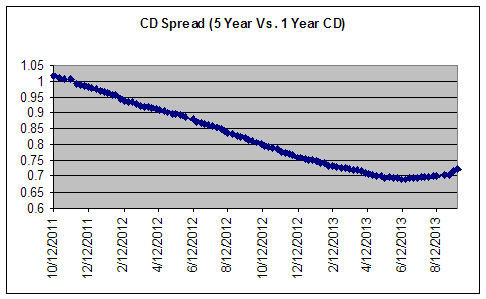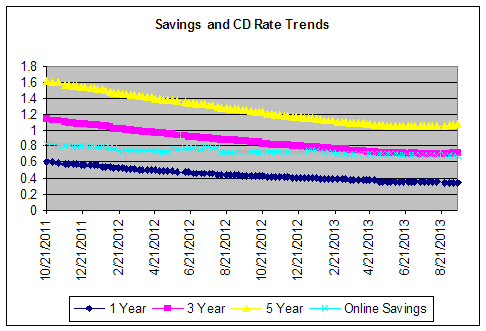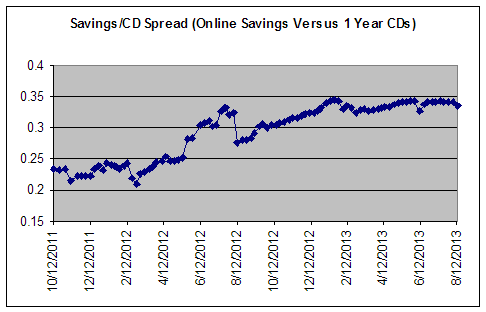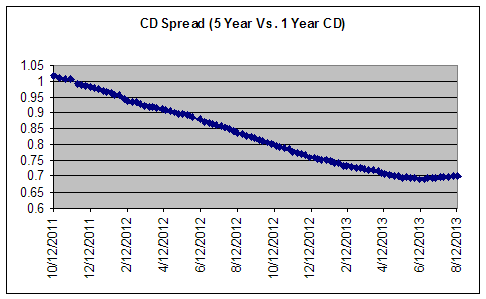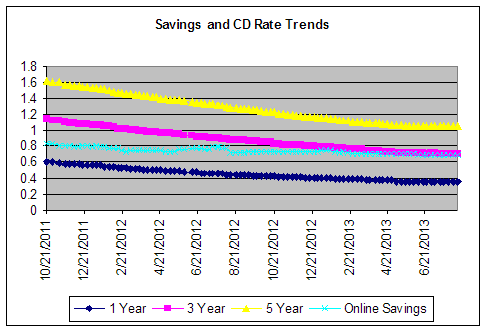Update: October 14, 2013
Shutdown talks have merged with the debt limit deadline. Washington is now sitting on a double powder keg of explosive news that has the potential to really knock the economy right out of the ring. All eyes have turned to Washington, not where you want the business world to be looking. The WSJ published an article (login required) today saying what we have known from the start, a prolonged government shutdown will hurt the economy and prolong the Fed's bond buying. That means lower rates for longer. Consumer confidence is already plummeting and the stock market is heading down. Throw in a debt default and we will have economic havoc. On days like this, I'm glad to have some of my money in cash, in good solid banks.
Update: October 7, 2013
It now looks like the shutdown talks are going to merge with the discussions on raising the debt limit. We've walked this tightrope before and it is a damaging game of brinksmanship our leaders are playing with the econony. If the issue is not resolved in the next week, look for these talks to create economic uncertainty and anxiety which will reduce growth, dampening interest rates for the next 6 months. In the unlikely case the government does default on its debt, all bets are off. The stock market will likely plunge, and interest rates on longer-term instruments such as mortgages will soar. Short term rates will remain low, as they are set by the Fed. But it might not matter because the financial markets could seize up. The global economic system relies heavily on Treasuries, and the fact that Treasuries are a risk-free instrument.
* * *
After weeks of back and forth bickering, the U.S. Federal government entered a partial shutdown today as Congress and the President failed to reach an agreement on a continuing budget resolution. While the politics of this are best left to other sites, we thought it wise to take a minute and think about what, if any impact this shutdown would have on savings and borrowing rates. The answer? It depends on how long the shutdown lasts and how the government is able to resolve it and move forward. A prolonged shutdown will slow confidence in the economy and increase unemployment, leading to lower rates on mortgages and other loans, as well as on savings and CD products.
Confidence is a mainstay of economic growth. If consumers are not confident about the future, they will delay purchases or not make them at all. Businesses act in the same way. The mad scramble in Washington does little to increase confidence and, if anything, makes both households and businesses wary about investing in the future. In addition, the inability for Congress and the President to agree on the continuing funding resolution bodes ill for the upcoming debt ceiling deadline. If the Federal government remains paralyzed and cannot fund itself, and this carries over to a default on U.S. debt, the results could be economically catastrophic. Why? Because U.S. government debt is considered to be risk free and this assumption is used to not only build portfolios, but calculate the return on projects and business investment. Any default would irretrievably alter this assumption. Domestic and global confidence would be sorely shattered.
The Federal government is the largest employer in the United States, providing jobs to over 4,00,000 individuals. The partial shutdown is expected to furlough 800,000 workers and another 1,000,000 employees are to work without pay. That means that at least 1.8 million employees will not receive payment for the duration of the shutdown. Depending on what Congress decides, furloughed workers do not need to be paid for their time out of work. Approximately 8.8 million jobs were lost during the Great Recession which means that the shutdown could have 17% of the impact of the Great Recession from a jobs standpoint. That seems pretty significant. Moody's Analytics estimates that failure to keep the government operating combined with a failure to raise the debt ceiling could cut fourth quarter economic growth by up to 1.4 percentage points. Considering that the baseline economy is only growing in the 2-2.5 percent range, that brings it perilously close to no growth.
The housing market may also suffer because of the shutdown. While the FHA says that it will continue to underwrite and approve new FHA loans, which constituted 45% of all mortgages used to purchase homes in 2012, it will only have a skeleton staff of 4% of its workforce to handle approximately 60,000 loans per month.
So, how will this all impact rates? The biggest driver of rates is the economy. If the economy is doing well, the Fed will begin to taper its purchase of bonds, and rates on mortgages and other lending products will rise, as they have been doing. In addition, longer-term deposit products, such as 5 year CD yields will also continue to go up. Eventually, as the economy gains more steam and the unemployment rate continues to fall, the Fed will raise the Fed funds rate and short term deposit rates, like savings accounts and money market account rates will also move up. The shutdown provides another tailwind to an economic recover, slowing the economy, and depressing both deposit and borrowing rates. The longer the shutdown, the stronger this tailwind.
- If you are a borrower, the longer the shutdown goes, the more it may lower borrowing rates. The recent run-up in mortgage rates was already muted by the Fed's decision to keep buying bonds. The shutdown will only reinforce this and extend the period of lower rates. But there is a steep downside since government backed mortgages will not be available.
- If you are a saver, the longer the shutdown goes, the more it will blunt the recent rise in long-term CD rates and prolong rock-bottom savings account rates.

